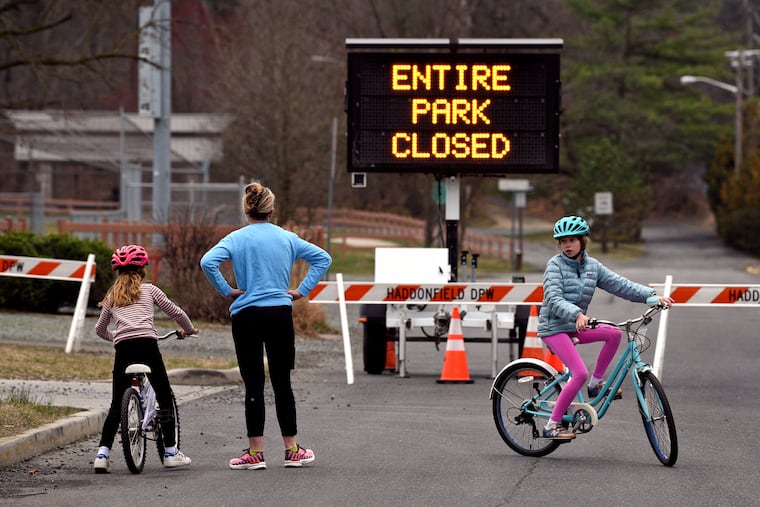Coronavirus ‘roller coaster’ will last months, not weeks, experts predict
"Normal" life will not resume for a year or more, if experts are right about the staying power of the coronavirus.

Over the last two months, most Americans have gone from blase to a siege mentality about the new coronavirus.
The concept of staying home and social distancing is now as familiar as it is disruptive, difficult, and economically dreadful.
Public officials, wary of further spooking their communities, have been talking about two or three weeks of closures and other emergency measures, then a reassessment.
But experts who have been running computer simulations of various scenarios are now publishing reality checks. Bottom line: The return to normal will not be soon or smooth.
“I’ve been estimating six to 10 weeks just to flatten the curve, not for containment” of the virus, said Michael LeVasseur, an epidemiologist and biostatistician at Drexel University.
“Flatten the curve” — another recent addition to the vernacular — refers to tamping down, but not stopping, an outbreak. That turns it into a more gradual rate of infection over a longer period of time so hospitals don’t get overwhelmed. This strategy, called mitigation, involves quarantining patients, social distancing, and closures of nonessential services and businesses.
Instead of a curve, picture a roller coaster, suggested University of Pennsylvania ethicist Ezekiel Emanuel, biostatistician Susan Ellenberg, and epidemiologist Michael Levy in an op-ed published in Tuesday’s New York Times.
“We need to be thinking in terms of months, not weeks,” they wrote.
China’s drastic lockdown of 57 million people in Hubei province, where the virus emerged in December, was aimed at not just flattening the curve but suppressing the virus. If suppression is successful, it reduces transmission to the point where an infected person spreads the virus to fewer than one other person on average. When this “reproduction number” is below one, the virus will eventually stop spreading in a susceptible population, and the death rate will be minimized.
Epidemiologists estimate that the coronavirus, if not uncontrolled, has a reproduction number of about 2.5 — meaning each infected person will infect 2.5 other people. Since the virus has probably been spreading undetected for weeks, the 2.5 reproduction number explains the exponential increase in cases that is hitting Pennsylvania, New Jersey, and most of the nation.
Here’s the rub, according to experts: Whether emergency measures are stringent (mitigation) or ultra-stringent (suppression), COVID-19 will come roaring back when people resume their normal routines because they still have no immune defense against the new virus.
An influential report published this week by Imperial College London concluded that “the main challenge” of suppression is that it needs “to be maintained — at least intermittently — for as long as the virus is circulating in the human population, or until a vaccine becomes available” in 12 to 18 months.
The Penn scientists, meanwhile, predict that staying home could reduce spread of the virus to near zero by late May. But if the precautions are eased, two to four more rounds of mitigation will be needed until a vaccine is developed and administered to at least 145 million people in the United States.
“If we are lucky, and an effective vaccine is quickly developed, this could happen by the fall of 2021,” they wrote.
The Imperial College mathematical models are considered so authoritative that they directly shape government policies. The new report used infection and death data from China, South Korea, and Italy to estimate what would happen in the United States and United Kingdom under various scenarios.
With uncontrolled spread, the Imperial team calculated, coronavirus would kill nearly four million Americans in a span of three months. With mitigation, the death rate would be cut in half, to about two million, including 900,000 who die because there aren’t enough ventilators. With suppression measures, the death rate would peak in three weeks at a few thousand, then decline.
The predictions served as an unnerving wake-up call for U.S. and U.K. leaders.
Hubei province — where new cases have subsided and the 50-day lockdown is gradually lifting — is expected to become a real-time illustration of the roller coaster of fighting coronavirus. So is South Korea, which tamed the virus through aggressive testing and isolation more than through shutdowns. (For every one million inhabitants, South Korea has tested 5,200; the comparable U.S. figure is 100, according to the COVID tracking project.)
Levy, an author of the op-ed, said Wednesday that he prefers another analogy in the article. The easing and resumption of emergency measures are like pumping a car’s brakes on an icy road to gradually stop it from skidding out of control.
“I don’t like the roller coaster analogy because it sounds like we’re along for the ride,” Levy said. “We have some ability to minimize the spread. We should expect the virus to come back, but each time, a little bit less.”
» READ MORE: Coronavirus testing sites draw worried crowds from around the Philadelphia region
While a reliable vaccine will take at least a year to develop and test, the impact of the pandemic could be lessened in the meantime if therapies now being tried are effective, and with the anticipated rollout of rapid, on-the-spot diagnostic tests. The current U.S. testing capacity continues to be woefully inadequate, experts agree, even though commercial tests are now supplementing the government’s supply.
“There are a lot of things we can do as a community to protect those who are most vulnerable,” said LeVasseur at Drexel. “But this is going to hurt. We’re all in this together, and that’s the only way we’re going to get out of this together.”